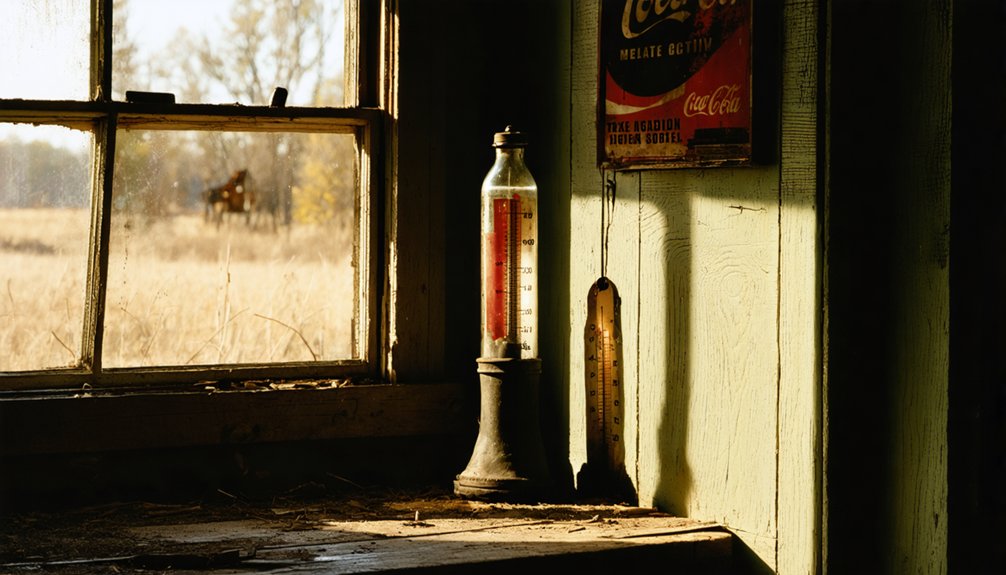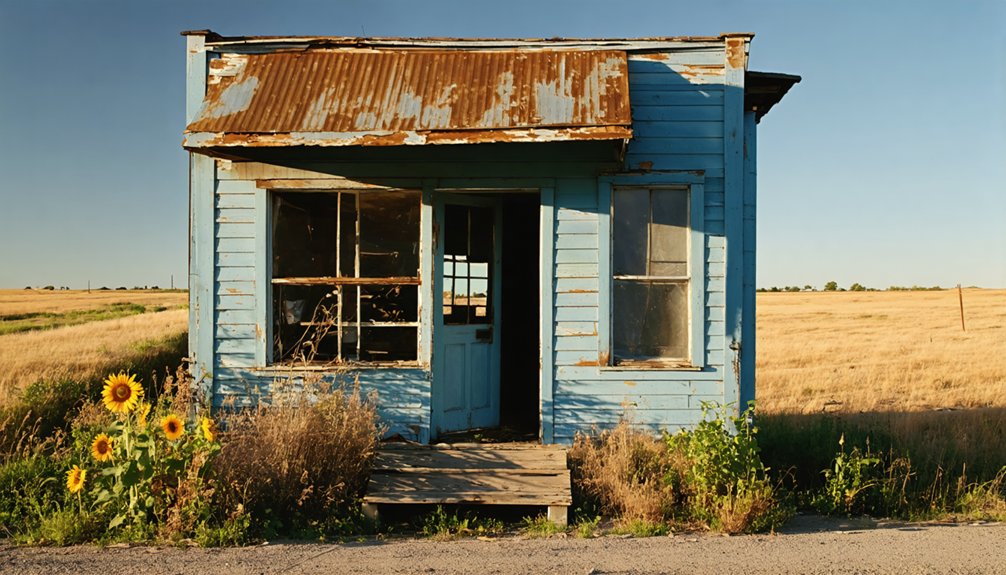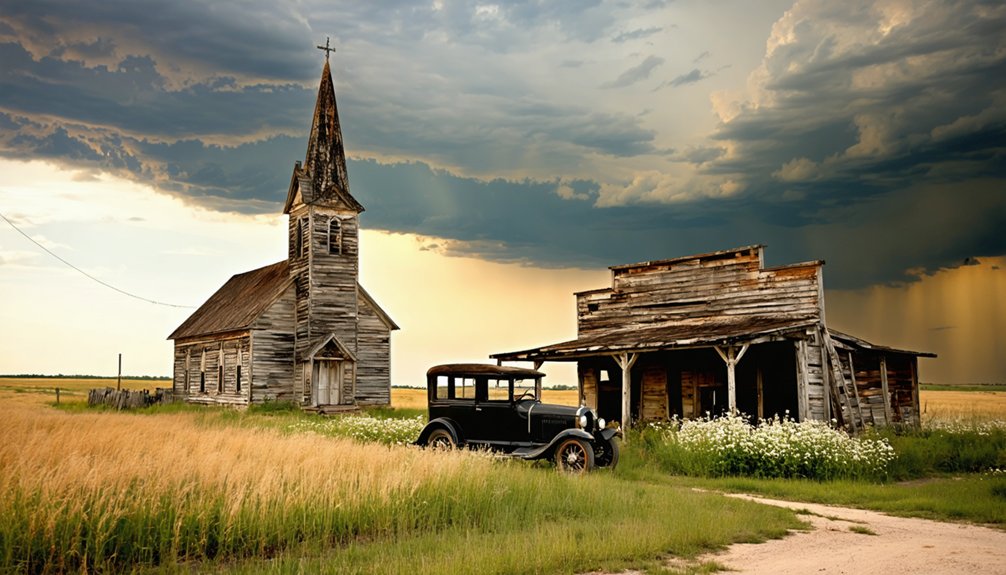You’ll find Hoover, South Dakota established in 1905 as a rural settlement named after John Hoover, a local cattleman. The town thrived during the railroad era with a bustling depot, grain elevators, and a general store that remains South Dakota’s oldest operating establishment. Though most original structures have vanished, abandoned sites and weathered remnants tell the story of this once-prosperous agricultural community’s eventual decline and desertion. The deeper history reveals a fascinating tale of frontier boom-and-bust.
Key Takeaways
- Hoover was established in 1905 as a rural settlement in Butte County, South Dakota, named after local cattleman John Hoover.
- The town’s economy initially thrived through mining and agriculture, with a railroad depot serving as a crucial hub for commerce.
- South Dakota’s oldest operating general store from 1902 remains as one of the few surviving structures in Hoover.
- Economic decline began in the early 1900s due to unprofitable mining and over-reliance on a single industry.
- Safety concerns and limited law enforcement, coupled with economic instability, led to the town’s eventual abandonment.
Early Settlement and Community Formation
While many small towns emerged across South Dakota in the early 1900s, Hoover established its presence in 1905 as a rural settlement in Butte County. The town’s community leadership centered around John Hoover, a local cattleman whose influence was significant enough to earn the town’s namesake.
Much like Herbert T. Hoover who grew up on a Minnesota farm, the early settlers of Hoover relied heavily on agriculture for their livelihood.
Like many settlements of the era, Hoover faced the harsh realities of weather and starting life from scratch in an untamed frontier.
Despite settlement challenges common to frontier establishments, Hoover’s development began even before its official founding, with a general store opening in 1902.
You’ll find that the town’s early infrastructure focused on essential services, particularly the post office established in 1905. This crucial communication hub operated continuously for nearly seven decades until its closure in 1973.
The settlement’s economic foundation rested firmly on farming and ranching activities, which shaped the community’s character and sustained its early growth.
Life in the Railroad Era
As Hoover’s early community took root, the arrival of railroad infrastructure throughout South Dakota marked a defining shift in the region’s development.
You’d find railroad innovations transforming daily life, with steam locomotives and mechanized freight handling revolutionizing how goods moved through the territory. The rail depot became your hub for community interactions, where you’d collect mail, send telegrams, and exchange news with neighbors. The completion of the transcontinental railroad in 1869 had already set precedent for how railways could transform communities.
If you lived in Hoover during this era, you’d witness the town’s growth directly tied to the railroad’s presence. The T-shaped layout common to railroad towns facilitated commerce, while grain elevators and warehouses near the rail sidings streamlined agricultural operations. Local speculators invested heavily in surrounding properties, anticipating substantial returns from the railroad’s expansion.
You’d benefit from increased land values, new job opportunities, and access to distant markets that the railroad network provided.
Notable Buildings and Landmarks
When you explore Hoover’s railroad-era landmarks today, you’ll find that most of its original structures, including the railroad depot and grain elevators, no longer exist.
The town’s historic business district has been largely reduced to its centerpiece – the 1902 general store, which stands as South Dakota’s oldest operating establishment of its kind. Like many towns, Hoover’s main businesses included two hotels and churches before its decline.
While other commercial buildings once lined the streets during Hoover’s peak years, the absence of their ruins or foundations suggests they were either dismantled or repurposed over time. Similar to how decreased tourist traffic impacted Rockerville in the 1990s, Hoover’s buildings gradually disappeared as the town lost its economic vitality.
Railroad Depot Operations
The railroad depot in Hoover served as an essential transportation and communication hub during the town’s heyday, connecting residents to regional and national networks.
Inside the depot architecture, you’d find dedicated spaces for ticket sales, freight logistics, and telegraph operations. The building’s design balanced functionality with modest stylistic elements common to late 19th and early 20th-century standards.
Like many South Dakota communities established during railroad expansion, Hoover followed a T-shaped layout pattern with its commercial district perpendicular to the tracks.
You could’ve witnessed station agents managing passenger services, coordinating freight shipments, and handling telegrams while locals gathered to exchange news.
The depot’s multiple tracks and sidings enabled efficient loading of agricultural products and other goods. Beyond its practical functions, the depot symbolized the railroad’s crucial role in Hoover’s development until post-WWII, when declining rail service began impacting small towns across South Dakota.
Grain Elevator Legacy
Standing alongside Hoover’s railroad depot, massive wooden grain elevators once dominated the skyline, serving as both functional storage facilities and symbols of agricultural prosperity.
These impressive structures, typically rising 50 feet high and spanning 20 feet wide, showcased the region’s robust elevator architecture through their crib-style construction of stacked 2x6s and 2x4s lumber.
You’ll find that these grain storage behemoths were engineering marvels of their time, featuring eight separate bins for segregating different grains.
Their construction required thousands of pounds of nails and extensive timber framing, yet they proved remarkably durable – many survived for over a century.
Early versions of these facilities used blind horse power to elevate and move grain before electrical systems were available.
While Hoover’s elevators, like many others across South Dakota, now stand silent, they remain powerful reminders of the area’s rich farming heritage.
The evolution from these wooden structures to concrete elevators marked a significant advancement in grain storage construction during the early twentieth century.
Historic Business District
Located in the heart of what was once a bustling prairie town, Hoover’s historic business district showcases an impressive collection of late 19th-century architecture. The area’s development was greatly influenced by James Taylor Ross in 1858, who provided crucial land for railway expansion.
You’ll find South Dakota’s oldest general store among the historic storefronts, featuring characteristic wood awnings and large display windows that reflect the era’s commercial architecture. The district’s false-front buildings exemplify frontier design and marketing methods that defined small-town commerce.
- Original clapboard siding and period-specific details remain intact on many structures
- The City Hall, converted from a historic commercial building, anchors the district
- Former mercantile buildings now serve contemporary community needs
- False-front designs create an authentic representation of frontier-era commercial streetscapes
These preserved structures stand as symbols of Hoover’s economic heritage, though many now sit vacant or repurposed.
Community Events and Social Life

Like many ghost towns across South Dakota, historical details about Hoover’s community events and social life remain scarce, with limited records surviving the town’s eventual abandonment.
Time has erased much of Hoover’s social history, leaving only fragments of memory from this vanished South Dakota town.
You’ll find that local legends and stories offer glimpses into what were once vibrant community gatherings and social traditions, rooted in the area’s agricultural heritage. While specific events aren’t documented, you can imagine the town’s social fabric was likely similar to other rural South Dakota communities of its time.
Today, you’ll discover that Hoover’s abandoned sites serve as silent witnesses to a once-thriving community.
Though access to some areas may be restricted, the town’s remnants continue to attract history enthusiasts and preserve the memory of South Dakota’s pioneering spirit through local preservation efforts.
Economic Rise and Development
Hoover’s economic story began with promising prospects during the late 1800s Black Hills boom period.
You’ll find evidence of a robust economy that emerged from both the mining boom and agricultural growth, with the establishment of crucial services by 1887 marking the town’s formal recognition.
The town’s economic dynamism was demonstrated through:
- Two thriving banks and three restaurants serving the growing population
- Multiple professional services including lawyers, physicians, and blacksmiths
- A thorough retail sector featuring general stores and drug shops
- Feed mills and grain dealerships supporting regional agricultural operations
Hard rock mining drove the local economy, while livestock operations and agriculture provided additional economic stability.
The town’s strategic location near proposed rail lines and main routes into the Black Hills initially attracted merchants and speculators, fueling rapid business development.
The Path to Abandonment

Hoover’s economic decline accelerated in the early 20th century as mining operations became unprofitable and mineral veins were exhausted.
You’ll find that the town’s mono-dependence on mining, coupled with its isolation from major transportation routes, left it particularly vulnerable when the industry collapsed.
The exodus of workers and their families followed swiftly, with the lack of economic diversification and deteriorating infrastructure making it impossible for the community to sustain itself.
Economic Factors Behind Decline
Though many ghost towns share similar paths to abandonment, the economic decline of Hoover, South Dakota followed a particularly stark trajectory marked by resource depletion and infrastructural challenges.
You’ll find the town’s economic downfall was accelerated by several key factors:
- Limited natural resources couldn’t sustain the local mining operations
- Young workers left in droves, creating devastating demographic shifts
- Infrastructure costs became too burdensome for remaining residents
- The town failed to diversify its economy beyond its primary industry
The combined pressure of these economic challenges proved insurmountable.
Without sufficient resources to maintain basic services and an aging population unable to sustain local businesses, Hoover’s fate was sealed.
The town’s isolation and lack of modern amenities made it increasingly difficult to attract new residents or businesses, ultimately leading to its abandonment.
Crime’s Role In Desertion
While economic decline played a significant role in Hoover’s abandonment, the town’s descent into lawlessness accelerated its demise during the late 1800s.
You’d find the limited law enforcement presence left the community vulnerable to criminal elements, with theft and violent confrontations becoming increasingly common.
The crime consequences rippled through daily life as saloon brawls and burglaries drove away law-abiding citizens and discouraged new settlers.
You could see how the community’s attempts at self-policing through vigilante justice only intensified the cycle of violence.
The frontier environment, combined with the transient nature of the mining population, created perfect conditions for criminal behavior.
As safety concerns mounted and infrastructure fell into neglect, remaining residents faced a stark choice: stay and risk their security or join the exodus to more stable communities.
Legacy and Present-Day Remains
The legacy of this South Dakota ghost town lives on primarily through its historic general store, established in 1902, which stands as a tribute to early 20th-century architecture and commerce.
A lasting testament to frontier commerce, Hoover’s 1902 general store endures as a rare glimpse into South Dakota’s pioneering past.
While much of Hoover’s infrastructure has vanished, the town’s cultural folklore and tourism potential remain untapped resources for preservation enthusiasts.
You’ll find these defining features in today’s Hoover:
- The original general store maintains its architectural integrity
- Historical markers commemorate the town’s agricultural past
- Rural landscapes dominate the surrounding area
- Limited modern development preserves the authentic ghost town atmosphere
Local preservation efforts, often led by volunteers and supported by the South Dakota State Historical Society, focus on maintaining what remains of this memorial to early frontier life.
Despite economic challenges, Hoover’s story continues to captivate those interested in American settlement history.
Frequently Asked Questions
Were There Any Famous Outlaws or Lawmen Associated With Hoover?
You won’t find any famous outlaws or lawmen connected to this town’s legacy. Unlike other Black Hills communities that attracted notorious characters, historical records show no significant law enforcement or criminal presence here.
What Was the Average Property Value During the Town’s Peak Years?
You’ll find property trends during Hoover’s peak were modest, with economic factors keeping values low. While exact figures aren’t documented, land and livestock held more value than buildings.
Did Any Natural Disasters Contribute to Hoover’s Eventual Abandonment?
While you might expect dramatic natural disasters led to its demise, there’s no evidence environmental factors caused Hoover’s abandonment. Instead, economic changes and infrastructure shifts were the main drivers of its decline.
What Happened to the Town’s Cemetery and Are There Maintained Graves?
You’ll find limited information about cemetery preservation at Hoover Cemetery. While it’s located off Highway 79 near Newell, there’s no confirmed data about grave maintenance or current condition of any markers.
Were There Any Significant Native American Settlements in the Area Before Hoover?
Like ancient spirits on the plains, you’ll find no major Native American settlements directly at this location – though the Sioux used the broader region for seasonal hunting and temporary camps.
References
- https://blackhillsvisitor.com/learn/owanka/
- https://www.youtube.com/watch?v=Glucs_Rq8Xs
- https://www.sdhspress.com/journal/south-dakota-history-2-2/some-black-hills-ghost-towns-and-their-origins/vol-02-no-2-some-black-hills-ghost-towns-and-their-origins.pdf
- https://www.sdpb.org/rural-life-and-history/2023-08-21/some-black-hills-ghost-towns-and-their-origins
- https://www.blackhillsbadlands.com/blog/post/old-west-legends-mines-ghost-towns-route-reimagined/
- https://aberdeenmag.com/2019/01/the-ghost-towns-of-brown-county/
- https://en.wikipedia.org/wiki/List_of_ghost_towns_in_South_Dakota
- https://freepages.history.rootsweb.com/~gtusa/usa/sd.htm
- https://www.southdakotamagazine.com/herbert-hoover-the-historian
- https://en.wikipedia.org/wiki/Hoover



